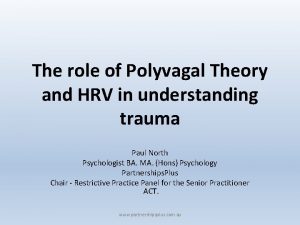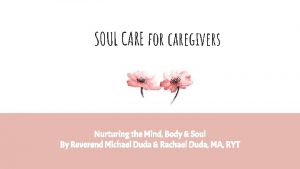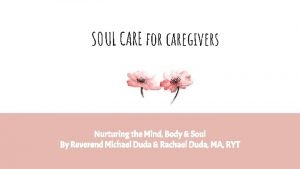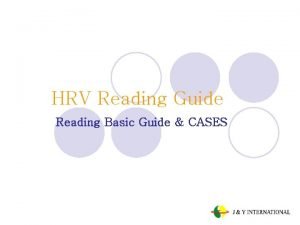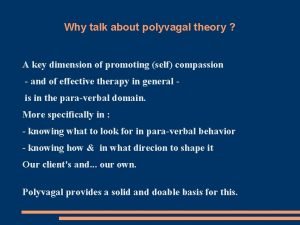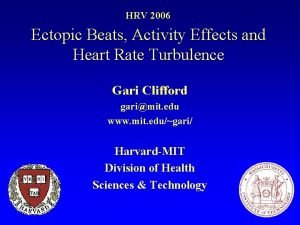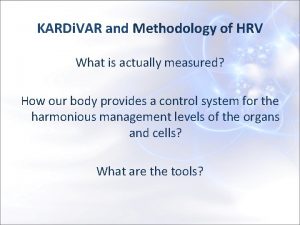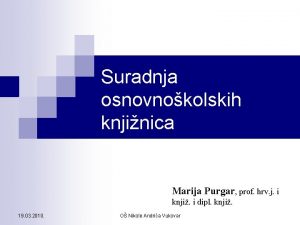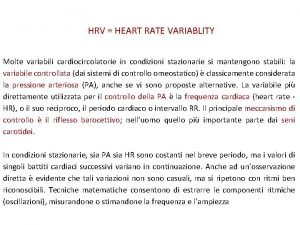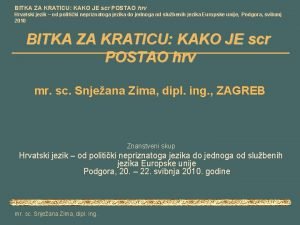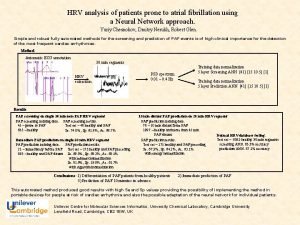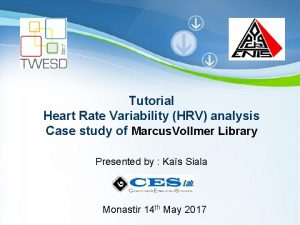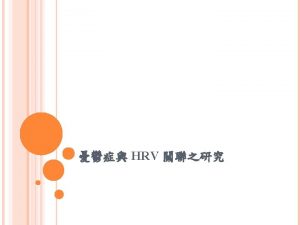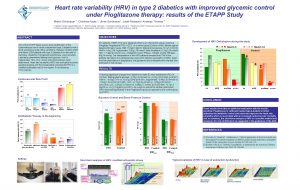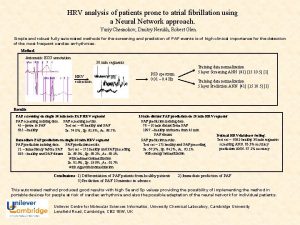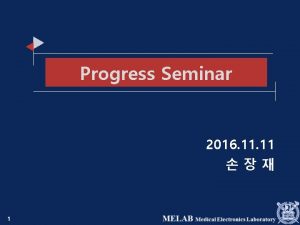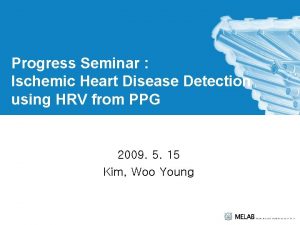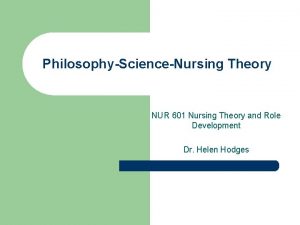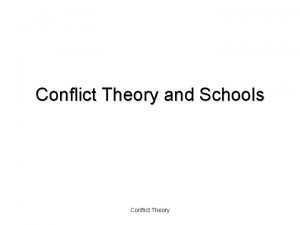The role of Polyvagal Theory and HRV in

































- Slides: 33

The role of Polyvagal Theory and HRV in understanding trauma Paul North Psychologist BA. MA. (Hons) Psychology Partnerships. Plus Chair - Restrictive Practice Panel for the Senior Practitioner ACT. www. partnershipsplus. com. au

Definition of Trauma • “Trauma is an experience that overwhelms our ability to cope and leaves our relationships and our brains with the challenge of finding a way to remain integrated and functioning well. ” Dan Siegel. • “ Trauma is the emotional, psychological and physiological residue left over from heightened stress that accompanies experiences of threat, violence, and life-challenging events. ” (Australian Childhood Foundation) www. partnershipsplus. com. au

Polyvagal Theory • • Developed by…. Professor Stephen Porges – Research Professor in the Department of Psychiatry at the University of North Carolina at Chapel Hill. – www. stephenporges. com www. partnershipsplus. com. au

Polyvagal Theory • We have more than one defence strategy Social Engagement System Fight or Flight Response Freeze Response A phylogenetically ordered response www. partnershipsplus. com. au

Freeze response • Primary defence system for reptiles • Most primitive defence mechanism for mammals • Generally dangerous for mammals • Cats and Mice • Not a conscious response • Called immobilisation www. partnershipsplus. com. au

Fight or Flight response • Allows mammals to be fast • More sophisticated than freeze response. Arises from the Cortex • Used to prevent the mammal from entering into the freeze response. • Porges calls this state Mobilisation www. partnershipsplus. com. au

Social Engagement System • • Most sophisticated response of a mammal. Arises from the middle prefrontal cortex. Nine important abilities of this area of the brain. 1. 2. 3. 4. 5. 6. 7. 8. 9. Regulate the body Capacity to tune into other people Capacity to balance emotions Capacity to be flexible Capacity to extinguish or modify fear Insight Empathy Morality Intuition www. partnershipsplus. com. au

www. partnershipsplus. com. au

Plane Crash www. partnershipsplus. com. au

Neuroception • The detection of features in others or the environment – without awareness –that dampens defensive systems and facilitates social behaviour OR • promotes defensive strategies of mobilisation (fight/flight) • OR immobilisation (shutdown/freeze/dissociation) www. partnershipsplus. com. au

Role of the Middle Ear: Extraction of Human Voice • Detached middle ear bones are a defining feature of mammals • Without detached middle ear bones, low amplitude sounds in higher frequencies would not be heard. Thus enabling mammals to communicate in a frequency band that is difficult to hear for reptiles. • Without functioning middle ear muscles we become hypersensitive to the low frequencies that signal a predator. www. partnershipsplus. com. au

The role of sound • Acoustic frequencies in well defined frequency bands trigger select physiological states via neuroception • Modulated frequencies on human voice (especially female) signal safety • Low frequencies signal predator • High frequencies signal pain or imminent danger. www. partnershipsplus. com. au

What can be done? • If the trauma affected brain is likely to be dysregulated and hypervigilant…. then what can we do to – Reduce the likelihood of this state of heightened arousal arising? – Increase a person’s opportunity for learning and recovering? – Build the person’s resilience in case of future trauma and stress? www. partnershipsplus. com. au

Safe and Sound Protocol (Originally called the Listening Project Protocol) • People with a trauma background often report hyperacusis ( being sensitive to sound is adaptive). • Designed to reduce auditory hypersensitivities • Improves neural tone of the middle ear muscles to facilitate increased dampening of low, flat sounds. • PVT emphasizes the role of middle ear in social communication www. partnershipsplus. com. au

2014 Study by Porges, et al. evaluating his protocol for reducing auditory hypersensitivites. • • 146 out of 178 children All met criteria for ASD All had auditory hypersensitivities Matched for behavioral difficulties Double Blind Randomized Control Two Trials Filtered music vs headphones only Filtered music vs unfiltered music. www. partnershipsplus. com. au

Results www. partnershipsplus. com. au

Results www. partnershipsplus. com. au

Hence, what are the ways we can help a person to feel safe? • Can he/she immobilise without fear? • Yes. If he/she is Safe. • Yes, if certain environmental factors are present. – – – – – Proximity to others Sound and prosody Facial Expressions (Mirror Neurons) Temperature Light Mindfulness Play Increase predictability Opportunities to regulate the neural platform to enable social engagement www. partnershipsplus. com. au

www. partnershipsplus. com. au

The neurobiology of a person exposed to repeated trauma • Higher levels of cortisol – affects memory/narrative, suppress immune system, reduces bone formation, sleep disturbance, increase appetite / obesity • Amygdala is larger – scans for danger, sensitive to fear, modulates aggression • Corpus collosum is narrower – difficulty reading social cues, abstract thinking, problem solving (falls behind their peers at age 10 -12) • Hippocampus is smaller – memory problems, disorientation • Harder to access pre-frontal cortex – chaos, rigidity, inflexibility (has difficulty regulating amygdala) www. partnershipsplus. com. au

Stress Response • Without the use of a persons hippocampus the amygdala does not restrict threatening stimuli to specific examples • Systems respond to minor stressors as if facing great threat (fight/flight or freeze) • Continuous perceived threat alters baseline arousal children can’t self-regulate • Amygdala comes to associate change with threat • The greater the stress the more we regress www. partnershipsplus. com. au

Polyvagal lens • What if the person has difficulty turning off his defense system because of trauma? • What if her behaviour was the adaptive function of regulating her physiological state? • What if his behaviour was neither “good” or “bad”? Behaviour is physiologically adaptive but does not fit the social context www. partnershipsplus. com. au

Porges’ view of the Autonomic Nervous System The metaphor of safety The stronger the stress the more we regress to an archaic form of survival Environment outside and inside the body Nervous System Safety • Parasympathetic myelinated vagus • Inhibits high states of arousal • Rest & digest • Supports Social Engagement System • Eye contact, facial expression, vocalisation • Fosters internal sensations associated with comfort and warmth • Attunes ear to sound of human voice Danger • Sympathetic Nervous system • Hyper-arousal • Increased heart rate, stops digestion • Mobilisation “fight / flight” • Disassociated rage/panic • Attunes ear for lower frequency predator sounds e. g. growls Life threat • Primitive unmyelinated vagus • Hyper-arousal • Slows heart rate, inhibits breathing, promotes defecation • Immobilisation “freeze” • Disassociation e. g. zone out, faint, feign death • Ears shutdown – minimal functioning • Potentially lethal to mammals who have a very high oxygen need www. partnershipsplus. com. au Adapted from Stephen Porges 2011

Heart rate variability (HRV) • Heart Rate Variability ( HRV) is the physiological phenomenon of variation in the time interval between heartbeats. It is measured by the variation in the beat-to-beat interval. www. partnershipsplus. com. au

Self Regulation • High HRV Effective Self Regulation • Low HRV Poor Self Regulation • Effective Self regulation is critical to physical and emotional well being www. partnershipsplus. com. au

Low Heart Rate Variability People with Low HRV…. • have trouble self regulating their emotions. • have a high cardiac risk(eg sudden heart attack/arrhythmia) • have elevated cortisol levels • have decreased immune function • are more likely to have increased BMI/obesity • Are more likely to have a reduced life span www. partnershipsplus. com. au

Groups that have low HRV People who suffer from • History of trauma • Depression • Anxiety • Epilepsy and Pseudo Epilepsy • Autism • Schizophrenia • Borderline Personality Disorder • Cadiomyopathy • Diabetes www. partnershipsplus. com. au

Medication and HRV • Tricyclic Antidepressants decrease HRV • SSRI’s may have a small effect on decreasing HRV • Risperidone does not appear to influence HRV (other anti-psychotics do) by itself, however, weigh gain is associated with the use of Risperdone and drug induced weight gain has been found to lower HRV in patients with Schizophrenia. www. partnershipsplus. com. au

Low HRV (Frustration) vs High HRV (Appreciation) www. partnershipsplus. com. au

Increasing HRV • Breathing (in for 3 out for 6 – from Polyvagal theory and equalised – in for 5 seconds, out 5 for seconds) • Contemplative practises ( e. g. Mindfulness, Compassion training, mindful colouring) • Singing, playing a wind instrument. • Focussed movement e. g. yoga, tai chi, sport • Resolving/integrating trauma through a combination of top down (eg TF-CBT) and bottom up (eg EMDR), therapies. www. partnershipsplus. com. au

• Questions www. partnershipsplus. com. au

References 1. Grossman P. , et al (2004). Mindfulness Based Stress Reduction and health benefits: A meta-analysis Journal of Psychosomatic Research 57 35– 43 2. Porges, S. W. , (2011) The Polyvagal Theory: Neurophysiological Foundations of Emotions, Attachment, Communication and Self –Regulation, Norton Series on Interpersonal Neurobiology (New York: WW Norton & Company, 2011) 3. Porges, S. W. , et al ( 2014). Reducing Auditory Hypersensitivites in Autism Spectrum Disorder: Preliminary Findings Evaluating the Listening Project Protocol. Frontiers in Pediatrics. Aug. 1 https: //doi. org/10. 3389/fped. 2014. 00080 4. van der Kolk, B. A. (2014) The Body Keeps the Score. Brain, Mind and Body in the Healing of Trauma. Penguin Group, New York. www. partnershipsplus. com. au

www. partnershipsplus. com. au
 Polyvagal theorie
Polyvagal theorie Polyvagal theory
Polyvagal theory Vagus nerve theory
Vagus nerve theory Hrvatskog narodnog preporoda
Hrvatskog narodnog preporoda Matura engleski 2017
Matura engleski 2017 C# azure worker role example
C# azure worker role example Lothar krappmann
Lothar krappmann Statuses and their related roles determine
Statuses and their related roles determine Model and role modeling theory
Model and role modeling theory Hình ảnh bộ gõ cơ thể búng tay
Hình ảnh bộ gõ cơ thể búng tay Slidetodoc
Slidetodoc Bổ thể
Bổ thể Tỉ lệ cơ thể trẻ em
Tỉ lệ cơ thể trẻ em Gấu đi như thế nào
Gấu đi như thế nào Tư thế worm breton là gì
Tư thế worm breton là gì Alleluia hat len nguoi oi
Alleluia hat len nguoi oi Các môn thể thao bắt đầu bằng từ đua
Các môn thể thao bắt đầu bằng từ đua Thế nào là hệ số cao nhất
Thế nào là hệ số cao nhất Các châu lục và đại dương trên thế giới
Các châu lục và đại dương trên thế giới Cong thức tính động năng
Cong thức tính động năng Trời xanh đây là của chúng ta thể thơ
Trời xanh đây là của chúng ta thể thơ Mật thư tọa độ 5x5
Mật thư tọa độ 5x5 101012 bằng
101012 bằng Phản ứng thế ankan
Phản ứng thế ankan Các châu lục và đại dương trên thế giới
Các châu lục và đại dương trên thế giới Thể thơ truyền thống
Thể thơ truyền thống Quá trình desamine hóa có thể tạo ra
Quá trình desamine hóa có thể tạo ra Một số thể thơ truyền thống
Một số thể thơ truyền thống Cái miệng nó xinh thế
Cái miệng nó xinh thế Vẽ hình chiếu vuông góc của vật thể sau
Vẽ hình chiếu vuông góc của vật thể sau Biện pháp chống mỏi cơ
Biện pháp chống mỏi cơ đặc điểm cơ thể của người tối cổ
đặc điểm cơ thể của người tối cổ Giọng cùng tên là
Giọng cùng tên là Vẽ hình chiếu đứng bằng cạnh của vật thể
Vẽ hình chiếu đứng bằng cạnh của vật thể
